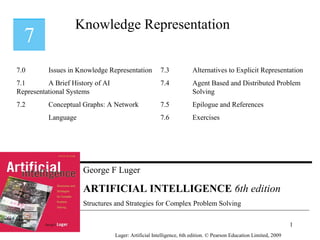Mais conteúdo relacionado
Semelhante a Artificial Intelligence (7)
Mais de Muhammad Ahad (20)
Artificial Intelligence
- 1. George F Luger
ARTIFICIAL INTELLIGENCE 6th edition
Structures and Strategies for Complex Problem Solving
Knowledge Representation
Luger: Artificial Intelligence, 6th edition. © Pearson Education Limited, 2009
7.0 Issues in Knowledge Representation
7.1 A Brief History of AI
Representational Systems
7.2 Conceptual Graphs: A Network
Language
7.3 Alternatives to Explicit Representation
7.4 Agent Based and Distributed Problem
Solving
7.5 Epilogue and References
7.6 Exercises
1
- 2. Fig 7.1 Semantic network developed by Collins and Quillian in their research on human
information storage and response times (Harmon and King, 1985)
Luger: Artificial Intelligence, 6th edition. © Pearson Education Limited, 2009
2
- 3. Fig 7.2 Network representation of properties of snow and ice
Luger: Artificial Intelligence, 6th edition. © Pearson Education Limited, 2009
3
- 4. Fig 7.3 three planes representing three definitions of the word “plant” (Quillian,
1967).
Luger: Artificial Intelligence, 6th edition. © Pearson Education Limited, 2009
4
- 5. Fig 7.4 Intersection path between “cry” and “comfort” (Quillian 1967).
Luger: Artificial Intelligence, 6th edition. © Pearson Education Limited, 2009
5
- 6. Fig 7.5 Case frame representation of the sentence “Sarah fixed the chair with
glue.”
Luger: Artificial Intelligence, 6th edition. © Pearson Education Limited, 2009
6
- 7. Conceptual dependency theory of four primitive conceptualizations
Luger: Artificial Intelligence, 6th edition. © Pearson Education Limited, 2009
7
- 8. Fig 7.6 Conceptual dependencies (Schank and Rieger, 1974).
Luger: Artificial Intelligence, 6th edition. © Pearson Education Limited, 2009
8
- 9. Fig 7.8 Some bacis conceptual dependencies and their use in representing more
complex English sentences, adapted from Schank and Colby (1973).
Luger: Artificial Intelligence, 6th edition. © Pearson Education Limited, 2009
9
- 10. Fig 7.9 Conceptual dependency representing “John ate the egg”
(Schank and Rieger 1974).
Fig 7.10 Conceptual dependency representation of the sentence “John prevented
Mary from giving a book to Bill” (Schank and Rieger 1974).
Luger: Artificial Intelligence, 6th edition. © Pearson Education Limited, 2009
10
- 11. Fig 7.11 a restaurant script (Schank and Abelson, 1977).
Luger: Artificial Intelligence, 6th edition. © Pearson Education Limited, 2009
11
- 13. Fig 7.12 Part of a frame description of a hotel room. “Specialization” indicates a
pointer to a superclass.
Luger: Artificial Intelligence, 6th edition. © Pearson Education Limited, 2009
13
- 14. Fig 7.13 Spatial frame for viewing a cube (Minsky, 1975).
Luger: Artificial Intelligence, 6th edition. © Pearson Education Limited, 2009
14
- 15. Fig 7.14 Conceptual relations of different arities.
Luger: Artificial Intelligence, 6th edition. © Pearson Education Limited, 2009
15
- 16. Fig 7.15 Graph of “Mary gave John the book.”
Luger: Artificial Intelligence, 6th edition. © Pearson Education Limited, 2009
16
- 17. Fig 7.16 Conceptual graph indicating that the dog named Emma is brown.
Fig 7.17 Conceptual graph indicating that a particular (but unnamed) dog is brown.
Fig 7.18 Conceptual graph indicating that a dog named Emma is brown.
Luger: Artificial Intelligence, 6th edition. © Pearson Education Limited, 2009
17
- 18. Fig 7.19 Conceptual graph of a person with three names.
Luger: Artificial Intelligence, 6th edition. © Pearson Education Limited, 2009
18
- 19. Fig 7.20 Conceptual graph of the sentence “The dog scratches its ear with its paw.”
Luger: Artificial Intelligence, 6th edition. © Pearson Education Limited, 2009
19
- 20. Fig 7.21 A type lattice illustrating subtypes, supertypes, the universal type, and the
absurd type. Arcs represent the relationship.
Luger: Artificial Intelligence, 6th edition. © Pearson Education Limited, 2009
20
- 21. Fig 7.22 Examples of restrict, join, and simplify operations.
Luger: Artificial Intelligence, 6th edition. © Pearson Education Limited, 2009
21
- 22. Fig 7.23 Inheritance in conceptual graphs.
Luger: Artificial Intelligence, 6th edition. © Pearson Education Limited, 2009
22
- 23. Fig 7.24 Conceptual graph of the statement “Tom believes that Jane likes pizza,”
showing the use of a propositional concept.
Luger: Artificial Intelligence, 6th edition. © Pearson Education Limited, 2009
23
- 24. Fig 7.25 Conceptual graph of the proposition “There are no pink dogs.”
Luger: Artificial Intelligence, 6th edition. © Pearson Education Limited, 2009
24
- 25. Fig 7.26 The functions of the three-layered subsumption architecture from Brooks
(1991a). The layers are described by the AVOID, WANDER, and EXPLORE
behaviours.
Luger: Artificial Intelligence, 6th edition. © Pearson Education Limited, 2009
25
- 26. Fig 7.27 A possible state of the copycat workspace. Several examples of bonds and
links between the letters are shown; adapted from Mitchell (1993).
Luger: Artificial Intelligence, 6th edition. © Pearson Education Limited, 2009
26
- 27. Fig 7.28 A small part of copycat’s slipnet with nodes, links, and label nodes shown;
adapted from Mitchell (1993).
Luger: Artificial Intelligence, 6th edition. © Pearson Education Limited, 2009
27
- 28. Fig 7.29 Two conceptual graphs to be translated into English.
Luger: Artificial Intelligence, 6th edition. © Pearson Education Limited, 2009
28
- 29. Fig 7.30 Example of analogy test problem.
Luger: Artificial Intelligence, 6th edition. © Pearson Education Limited, 2009
29

